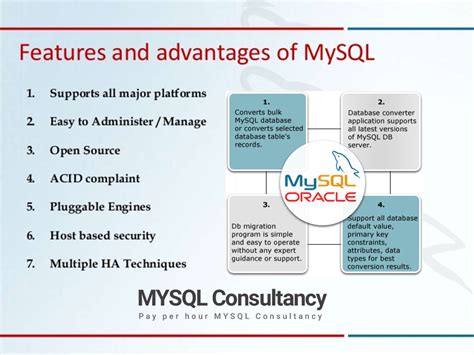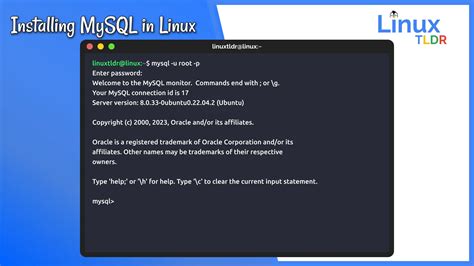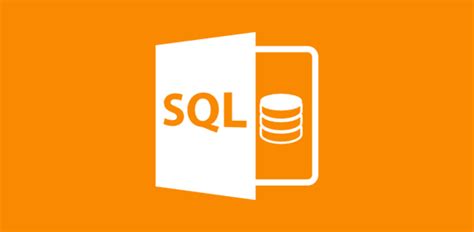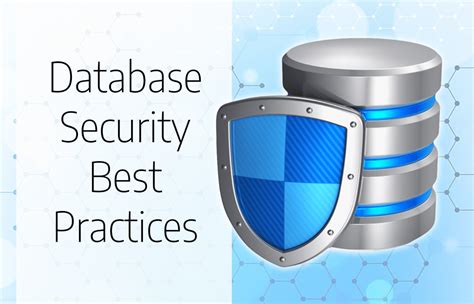Are you a Linux enthusiast or a developer looking to enhance your skills in managing databases? Look no further! This in-depth article will provide you with a comprehensive understanding of the intricacies involved in handling and manipulating databases in a Linux environment.
Whether you're working with MySQL, PostgreSQL, or other popular database management systems, this guide will equip you with the necessary knowledge and techniques to effectively store, organize, and retrieve data. You'll gain insights into the fundamental principles of database management, enabling you to optimize performance, ensure data integrity, and implement robust security measures.
Unlock the full potential of your Linux system as you delve into the world of databases. Our step-by-step explanations, supplemented with real-world examples, will guide you through setting up and configuring your databases, creating and managing tables, and performing complex queries. Gain a deep understanding of the SQL language and learn how to utilize it to unleash the power of your data.
Embrace the versatility and flexibility Linux offers for managing databases. By the end of this guide, you'll have the tools and skills to confidently handle various database-related tasks such as data backup and restoration, user management, and data replication. No matter your experience level, this article will enrich your knowledge and empower you to overcome the challenges that come with managing databases in Linux.
Understanding MySQL: Features and Functionality

In this section, we will delve into the intricacies of MySQL and explore its vast range of features and functionalities. MySQL, a powerful and widely-used open-source relational database management system, offers a plethora of tools and capabilities for efficiently handling data and optimizing performance. By gaining a solid understanding of MySQL's features, you will be empowered to make informed decisions and unleash the true potential of your database management.
1. Data Storage and Organization:
- MySQL provides a flexible and scalable storage model, allowing you to efficiently store and retrieve data.
- The database organizes data into tables, which are further divided into rows and columns, enabling easy organization and retrieval of information.
- MySQL supports various data types, including numeric, string, date, and spatial data, allowing for diverse data storage requirements.
- With MySQL's indexing capabilities, you can enhance the performance of your queries by efficiently locating and retrieving specific data.
2. Data Manipulation:
- MySQL offers a comprehensive set of SQL commands for manipulating data, allowing you to insert, update, and delete records in the database.
- Using SQL queries, you can search for specific data, filter results, and combine data from multiple tables through powerful join operations.
- MySQL provides advanced aggregate functions for performing calculations and summarizing data, allowing for in-depth analysis and reporting.
- Transactions in MySQL ensure the integrity and consistency of your data by grouping multiple database operations into atomic units.
3. Data Security:
- MySQL offers robust security features, including user authentication and authorization mechanisms, to ensure data confidentiality and integrity.
- By assigning different privileges to users and roles, you can control and restrict access to specific databases, tables, or columns.
- MySQL supports encryption of data, both during transmission and storage, providing an additional layer of protection against unauthorized access.
- Regular backups and recovery options offered by MySQL help safeguard your data and mitigate the impact of hardware failures or human errors.
4. Performance Optimization:
- MySQL offers various optimization techniques, such as query optimization and indexing strategies, to improve query execution speed and overall performance.
- By analyzing query execution plans and utilizing performance tuning tools, you can identify and resolve bottlenecks for optimal database performance.
- MySQL's caching mechanisms, including query cache and buffer pool, enhance data retrieval speed by caching frequently accessed data in memory.
- With MySQL's replication capabilities, you can distribute the database workload across multiple servers, improving scalability and availability.
By comprehending the diverse features and functionality of MySQL, you will be equipped with the knowledge to efficiently manage and optimize your database, resulting in enhanced productivity and performance.
Exploring the Advantages and Versatile Applications of PostgreSQL
In this section, we will delve into the numerous advantages that PostgreSQL offers as a powerful and feature-rich open-source database management system. We will also explore its versatile applications across various industries and use cases.
PostgreSQL, often referred to as "Postgres," is a robust and reliable database system known for its scalability, extensibility, and ACID-compliant design. It stands out as an excellent choice for businesses and developers seeking a flexible and high-performance database solution.
One of the key advantages of PostgreSQL is its ability to handle complex and dynamic data structures. It supports a wide range of data types, including text, numeric, boolean, array, JSON, and even user-defined types. This flexibility allows developers to adapt the database to meet unique requirements and store diverse types of data seamlessly.
Another notable advantage is PostgreSQL's adherence to standards and its rich set of features. It fully complies with the SQL standard and provides advanced functionality, such as support for complex queries, transaction management, data integrity constraints, and powerful indexing mechanisms. Its extensive feature set makes it suitable for handling demanding applications and large-scale databases.
PostgreSQL also excels in performance, providing efficient and optimized query execution. Its query optimizer applies various optimization techniques to enhance performance, such as intelligent index usage, parallel processing, and caching mechanisms. Additionally, PostgreSQL's multi-version concurrency control (MVCC) approach allows multiple transactions to operate concurrently without compromising data integrity.
When it comes to applications, PostgreSQL finds extensive use in diverse industries. It serves as a reliable data store for e-commerce platforms, content management systems, scientific research databases, geospatial applications, financial systems, and much more. Its ability to handle complex data relationships, support advanced analytics, and provide robust security features makes it a preferred choice for various business-critical applications.
In conclusion, PostgreSQL offers a multitude of advantages, ranging from its flexibility and adherence to standards to its performance and versatile applications. Its ability to handle complex data structures, support advanced functionality, and provide scalability and reliability make it an excellent option for businesses and developers looking for a comprehensive and powerful database management system.
| Advantages of PostgreSQL | Applications of PostgreSQL |
|---|---|
| Scalability | E-commerce platforms |
| Extensibility | Content management systems |
| ACID compliance | Scientific research databases |
| Support for diverse data types | Geospatial applications |
| SQL standard compliance | Financial systems |
| Advanced query optimization | Business-critical applications |
Installing and Configuring MySQL on a Linux System

In this section, we will explore the process of installing and setting up the MySQL database management system on a Linux operating system. MySQL is a popular and powerful relational database that is widely used for web applications and other data-intensive projects. By following these step-by-step instructions, you will be able to successfully install MySQL on your Linux system, and configure it for optimal performance.
Step 1: Checking System Requirements
Before you begin the installation process, it is important to ensure that your Linux system meets the necessary requirements for running MySQL. This includes having a supported Linux distribution, ensuring that you have sufficient disk space, and having the necessary dependencies installed. By checking these requirements, you can ensure a smooth installation process.
Step 2: Downloading MySQL
Once you have confirmed that your system meets the requirements, you can proceed to download the MySQL package from the official website. The MySQL Community Edition is available for free and provides all the necessary components for running a basic MySQL installation on Linux. By following the provided links and instructions, you can obtain the correct package for your Linux distribution.
Step 3: Installing MySQL
After downloading the MySQL package, you can begin the installation process. This typically involves running a series of commands in the terminal to install the necessary files and services. By carefully following the provided installation instructions, you can ensure that MySQL is installed correctly on your Linux system.
Step 4: Configuring MySQL
Once the installation is complete, you will need to configure MySQL to suit your specific needs. This includes setting the root password, adjusting security settings, and optimizing performance parameters. By modifying the MySQL configuration file and running the necessary commands, you can customize MySQL to meet the requirements of your application.
Step 5: Verifying the Installation
Finally, it is crucial to verify that the MySQL installation was successful. This involves testing the connection to the MySQL server, ensuring that the necessary processes are running, and checking for any errors or warnings. By following the provided instructions, you can confirm that MySQL is installed and functioning correctly on your Linux system.
| Steps | Description |
|---|---|
| Step 1 | Checking System Requirements |
| Step 2 | Downloading MySQL |
| Step 3 | Installing MySQL |
| Step 4 | Configuring MySQL |
| Step 5 | Verifying the Installation |
Optimizing PostgreSQL for Maximum Performance
In this section, we will explore ways to fine-tune the performance of your PostgreSQL database to ensure optimal efficiency and responsiveness. By optimizing the configuration settings and implementing best practices, you can enhance the overall performance of your PostgreSQL database system.
- Tuning Memory Settings: Adjusting memory parameters such as shared_buffers, effective_cache_size, and work_mem can significantly impact the performance of your PostgreSQL database. We will discuss how to determine appropriate values for these parameters based on your system's hardware and workload requirements.
- Optimizing Disk I/O: Properly configuring your PostgreSQL database's disk storage can greatly improve its performance. We will explore methods such as segregating database files onto different disks or mount points, utilizing RAID configurations, and understanding the impact of block size on I/O performance.
- Query Optimization: Efficiently written queries play a vital role in achieving optimal performance. We will delve into techniques such as query rewriting, indexing, and using appropriate join techniques to enhance query execution time.
- Monitoring and Logging: Monitoring the performance of your PostgreSQL database system is crucial for identifying and addressing any performance bottlenecks. We will discuss various monitoring tools and techniques, as well as utilizing PostgreSQL's logging features to gather performance-related data for analysis.
- Configuring Connection Pooling: Setting up connection pooling enables efficient handling of database connections, reducing overhead and improving performance in scenarios involving multiple client connections. We will explore popular connection pooling solutions and steps to configure them with PostgreSQL.
By implementing the recommendations and techniques outlined in this section, you can optimize the performance of your PostgreSQL database system, ensuring it is capable of handling high volumes of data and queries effectively.
Creating and Managing Databases: A MySQL Primer

In this section, we will delve into the fundamentals of creating and managing databases using the popular MySQL database management system. We will explore the essential concepts and techniques needed to effectively work with MySQL databases, enabling you to store, organize, and retrieve your data efficiently. Whether you are a seasoned database administrator or just starting out, this comprehensive guide will equip you with the necessary knowledge to create and manage databases seamlessly.
Understanding the Database Structure:
Before diving into the creation and management of databases, it is crucial to grasp the foundational aspects of database structures. We will explore the key components that make up a MySQL database, such as tables, columns, and data types. By understanding these components, you will gain insights into how to design and organize your databases effectively, ensuring optimal performance and data integrity.
Creating a Database:
Creating a database is the first step towards storing your data systematically. We will guide you through the process of creating a MySQL database, highlighting different methods that you can employ, both through MySQL command-line tools and graphical interfaces. You will learn how to define the name of the database and set various parameters, such as character encoding and collation, to suit your specific requirements.
Managing Database Users and Privileges:
Securing your databases is paramount, and in this section, we will explore how to manage database users and their privileges effectively. You will learn how to create users, grant or revoke privileges, and control their access levels. We will also cover best practices for securing your MySQL databases, such as using strong passwords and implementing robust authentication mechanisms.
Designing and Modifying Database Tables:
The structure of database tables plays a crucial role in organizing your data efficiently. We will delve into the process of designing and modifying MySQL database tables, covering essential aspects like data types, indexing, and relationships between tables. By understanding these concepts, you'll be able to create well-designed tables that facilitate seamless data manipulation and retrieval.
Performing Database Queries:
Interacting with your databases involves retrieving, updating, and deleting data using SQL queries. We will guide you through the process of constructing effective queries using the SQL language. You will learn various SELECT statements to retrieve specific data, as well as INSERT, UPDATE, and DELETE statements to manipulate your database records. Additionally, we will cover advanced querying techniques, such as joins and subqueries, to enhance your data retrieval capabilities.
Backup and Restoration:
Data loss can be catastrophic, which is why regular backups are essential. We will explore different methods for backing up your MySQL databases, including using native MySQL tools and third-party solutions. Additionally, we will walk you through the restoration process, enabling you to recover your databases in the event of accidental data loss or corruption.
Optimizing Database Performance:
Optimizing database performance is crucial for ensuring efficient data processing and retrieval. We will cover various techniques to boost MySQL database performance, including index optimization, query optimization, and configuration tuning. By implementing these strategies, you will be able to enhance the speed and responsiveness of your databases, enabling faster application performance.
Conclusion:
In this section, we have provided a comprehensive overview of creating and managing databases with MySQL. By understanding the foundational concepts and employing best practices, you can harness the power of MySQL to store and retrieve your data effectively. With the knowledge gained from this guide, you'll be equipped to confidently create and manage databases, ensuring data integrity, security, and optimal performance.
Exploring PostgreSQL Data Types and Manipulation
Understanding the intricacies of PostgreSQL data types and manipulation is crucial in effectively working with this powerful database management system. In this section, we will delve into the various data types supported by PostgreSQL and explore the techniques for manipulating and extracting data.
- Introduction to PostgreSQL Data Types
- Primitive Data Types
- Composite Data Types
- Specialized Data Types
- Manipulating Data in PostgreSQL
- Inserting and Updating Data
- Retrieving and Querying Data
- Transforming Data using Functions and Operators
The PostgreSQL database offers a diverse range of data types that cater to specific needs and requirements. We will begin by familiarizing ourselves with the core concepts behind PostgreSQL data types, including the distinction between primitive and composite types, as well as specialized types like arrays and geometric data.
Once we have a solid foundation in data types, we will explore the techniques for manipulating data within PostgreSQL. This includes understanding the syntax for inserting and updating records, as well as retrieving and querying data using SQL statements. We will uncover the power of filtering, sorting, and joining data to extract meaningful insights.
Additionally, we will dive into the realm of advanced data manipulation techniques within PostgreSQL. This involves leveraging functions and operators to transform data, perform calculations, and create custom expressions. We will explore built-in functions, as well as how to create user-defined functions to extend the functionality of PostgreSQL.
By the end of this section, you will have a comprehensive understanding of PostgreSQL data types and be equipped with the necessary skills to manipulate and extract data effectively from your PostgreSQL database.
Securing Your Database: Best Practices and Tools

Ensuring the security of your database is crucial in today's digital landscape. In this section, we will explore the best practices and tools available to enhance the security of your database system.
Understanding the Importance of Database Security
Effective database security measures are essential to protect sensitive information, prevent unauthorized access, and safeguard against data breaches or malicious activities. By implementing proper security practices, you can enhance the overall integrity and reliability of your database system.
Implementing Access Control Policies
Access control policies play a vital role in database security. They define and regulate who can access the database, what operations they can perform, and under what circumstances. By implementing robust access control policies, you can restrict unauthorized access and minimize the potential risk of data breaches.
Using Encryption for Data Protection
Data encryption is a powerful technique that transforms data into an unreadable format, known as ciphertext, using cryptographic algorithms. By encrypting sensitive data stored in your database, you can ensure that even if unauthorized users gain access to the data, they cannot decipher its meaning.
Regularly Backing Up Your Database
Regularly backing up your database is a fundamental practice to protect your data from accidental loss, disaster recovery, and security incidents. By having up-to-date backups, you can restore your database to a known well-secured state in case of data corruption or breach.
Implementing Database Monitoring and Auditing
Database monitoring and auditing allow you to track and analyze activities happening within your database system. By employing monitoring tools, you can detect suspicious behavior, identify potential vulnerabilities, and respond promptly to any security incidents.
Using Security Tools and Techniques
There are various security tools and techniques available specifically designed to enhance the security of databases. This may include database firewalls, intrusion detection systems, vulnerability scanners, and encryption key management systems. By leveraging these tools, you can further fortify the security of your database system.
Stay Up to Date with Security Patches and Updates
Regularly updating your database management system with the latest security patches and updates is crucial to address known vulnerabilities and exploit fixes. By staying up to date, you can ensure that your database system remains protected against emerging threats and security risks.
Conclusion
Securing your database is a continuous process that requires a combination of best practices and tools. By following the recommendations outlined in this section, you can significantly enhance the security of your database system and protect your valuable data from potential threats.
FAQ
What are some common databases used in Linux?
Some common databases used in Linux are MySQL and PostgreSQL.
What is the difference between MySQL and PostgreSQL?
The main differences between MySQL and PostgreSQL are their license, data type support, and replication capabilities. MySQL has a more permissive license, while PostgreSQL has a more restrictive one. In terms of data type support, PostgreSQL provides more options and advanced features compared to MySQL. Additionally, PostgreSQL has more robust replication capabilities, allowing for high availability and data redundancy.
How can I install MySQL on Linux?
To install MySQL on Linux, you can use the package manager of your Linux distribution. For example, on Ubuntu, you can use the command "sudo apt-get install mysql-server". After installation, you can start the MySQL service and configure it according to your needs.
What are some basic database operations I can perform in Linux?
In Linux, you can perform basic database operations such as creating a database, creating tables, inserting data into tables, retrieving data using queries, updating records, and deleting records. These operations can be done using SQL commands or through graphical user interfaces provided by database management tools.




